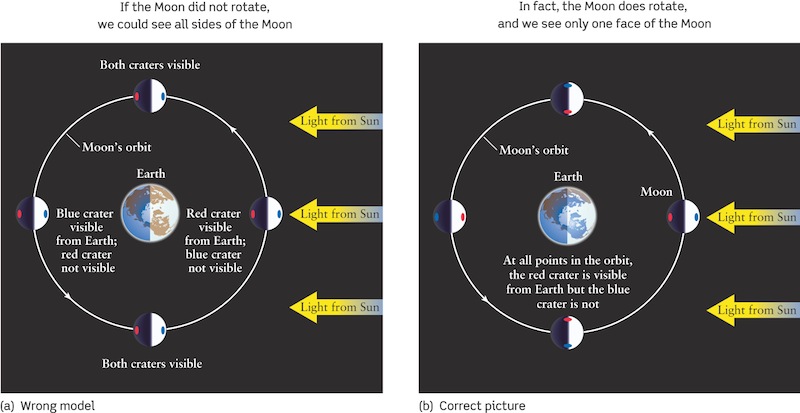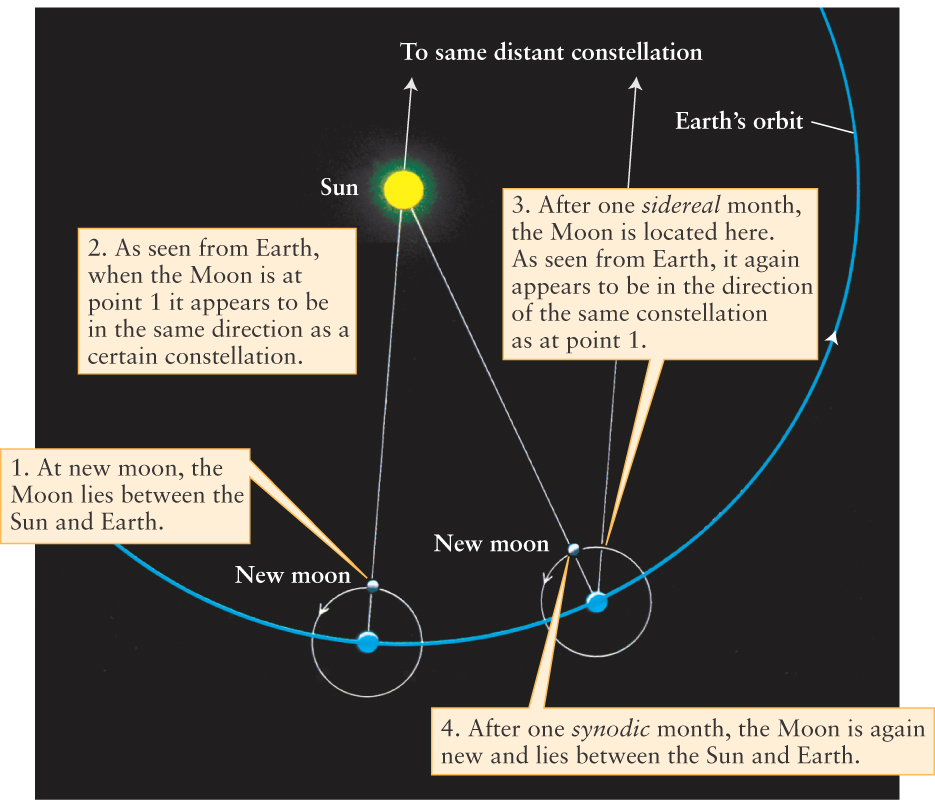3-2 The Moon always keeps the same face toward Earth
The Moon rotates in a special way: It spins exactly once per orbit
Although the phase of the Moon is constantly changing, one aspect of its appearance remains the same: It always keeps essentially the same hemisphere, or face, toward Earth. Thus, you will always see the same craters and mountains on the Moon, no matter when you look at it; the only difference will be the angle at which these surface features are illuminated by the Sun. (You can verify this by carefully examining the photographs of the Moon in Figure 3-2.)
The Moon’s Synchronous Rotation
Why is it that we only ever see one face of the Moon? You might think that it is because the Moon does not rotate (unlike Earth, which rotates around an axis that passes from its north pole to its south pole). To see that the Moon must rotate, consider Figure 3-4. This figure shows Earth and the orbiting Moon from a vantage point far above Earth’s north pole. In this figure two craters on the lunar surface have been colored, one in red and one in blue. If the Moon did not rotate on its axis, as in Figure 3-4a, sometimes the red crater would be visible from Earth, while at other times the blue crater would be visible. Thus, we would see different parts of the lunar surface over time, which does not happen in reality.

 The Moon’s Rotation These diagrams show the Moon at four points in its orbit as viewed from high above Earth’s north pole. (a) The wrong model: If the Moon did not rotate, then at various times the red crater would be visible from Earth while at other times the blue crater would be visible. Over a complete orbit, the entire surface of the Moon would be visible. (b) In reality, the Moon rotates on its north-south axis. Because the Moon makes one rotation in exactly the same time that it makes one orbit around Earth, we see only one face of the Moon.
The Moon’s Rotation These diagrams show the Moon at four points in its orbit as viewed from high above Earth’s north pole. (a) The wrong model: If the Moon did not rotate, then at various times the red crater would be visible from Earth while at other times the blue crater would be visible. Over a complete orbit, the entire surface of the Moon would be visible. (b) In reality, the Moon rotates on its north-south axis. Because the Moon makes one rotation in exactly the same time that it makes one orbit around Earth, we see only one face of the Moon.
In fact, the Moon always keeps the same face toward us because it is rotating, but in a very special way: It takes exactly as long for the Moon to rotate on its axis as it does to make one orbit around Earth. This situation is called synchronous rotation. As Figure 3-4b shows, this keeps the crater shown in red always facing Earth, so that we always see the same face of the Moon. In Chapter 4 we will learn why the Moon’s rotation and orbital motion are in step with each other.
Is there a permanently “dark side of the Moon?” Not at all. To understand this, consider the red crater in Figure 3-4b. The red crater would spend two weeks (half of a lunar orbit) in darkness, and the next two weeks in sunlight. Thus, no part of the Moon is perpetually in darkness. The side of the Moon that constantly faces away from Earth is properly called the far side.
CONCEPT CHECK 3-3
Viewed from space, the far side of the Moon is fully dark at only one point during the lunar orbit. Can you identify this point in Figure 3-4b?
The Moon is shown at four points of its orbit in Figure 3-4b. In the left position, the far side is fully dark.
CONCEPT CHECK 3-4
If astronauts landed on the Moon near the center of the visible surface at full moon, how many Earth days would pass before the astronauts experienced darkness on the Moon?
If the Moon is full, then after one week, it would reach the third quarter phase, and the point that used to be in the center of the Moon’s visible surface at full moon would now fall into darkness that would last for two weeks. This scenario can be seen in two figures: In Figure 3-4b, this scenario is shown by the red dot on the leftmost depiction of the Moon, and the Moon’s position a week later at the bottom of the figure. In Figure 3-2, this scenario occurs between positions E and G.
Sidereal and Synodic Months
It takes about four weeks for the Moon to complete one cycle of its phases as seen from Earth. This regular cycle of phases inspired our ancestors to invent the concept of a month. For historical reasons, the calendar we use today has months of differing lengths. Astronomers find it useful to define two other types of months, depending on whether the Moon’s motion is measured relative to the stars or to the Sun. Neither corresponds exactly to the familiar months of the calendar.
The sidereal month is the time it takes the Moon to complete one full orbit of Earth, as measured with respect to the stars. The sidereal period is what you would observe while hovering in space (like the stars), watching the Moon orbit Earth. This true orbital period is equal to about 27.32 days. The synodic month, or lunar month, is the time it takes the Moon to complete one cycle of phases (that is, from new moon to new moon or from full moon to full moon) and thus is measured with respect to the Sun rather than the stars.
How long is a “day” on the Moon? On Earth, a 24-hour day measures the average time between successive sunrises (or sunsets). Therefore, a day on Earth is measured with respect to the Sun and is a synodic day. The lunar “day” is also the time from sunrise to sunrise as seen from the Moon’s surface, and this is just what defines the Moon’s synodic month; a lunar day is equal to a synodic month.
The synodic month is longer than the sidereal month because Earth is orbiting the Sun while the Moon goes through its phases. As Figure 3-5 shows, the Moon must travel more than 360° along its orbit to complete a cycle of phases (for example, from one new moon to the next). Because of this extra distance, the synodic month is equal to about 29.53 days, about two days longer than the sidereal month.

 The Sidereal and Synodic Months The sidereal month is the time the Moon takes to complete one full revolution around Earth with respect to the background stars. However, because Earth is constantly moving along its orbit about the Sun, the Moon must travel through slightly more than 360° of its orbit to get from one new moon to the next. Thus, the synodic month—the time from one new moon to the next—is longer than the sidereal month.
The Sidereal and Synodic Months The sidereal month is the time the Moon takes to complete one full revolution around Earth with respect to the background stars. However, because Earth is constantly moving along its orbit about the Sun, the Moon must travel through slightly more than 360° of its orbit to get from one new moon to the next. Thus, the synodic month—the time from one new moon to the next—is longer than the sidereal month.
Both the sidereal month and synodic month vary somewhat from one orbit to another, the latter by as much as half a day. The reason is that the Sun’s gravity sometimes causes the Moon to speed up or slow down slightly in its orbit, depending on the relative positions of the Sun, Moon, and Earth. Further-more, the Moon’s orbit changes slightly from one month to the next.
CONCEPT CHECK 3-5
If Earth was orbiting the Sun much faster than it is now, would the length of time between full moons increase, decrease, or stay the same?
Increase. If Earth was moving around the Sun faster than it is now, Earth would move farther around the Sun during the Moon’s orbit and it would take longer for the Moon to reach the position where it was in line with the Sun and Earth, increasing its synodic period. This is illustrated (for the new moon) in Figure 3-5.